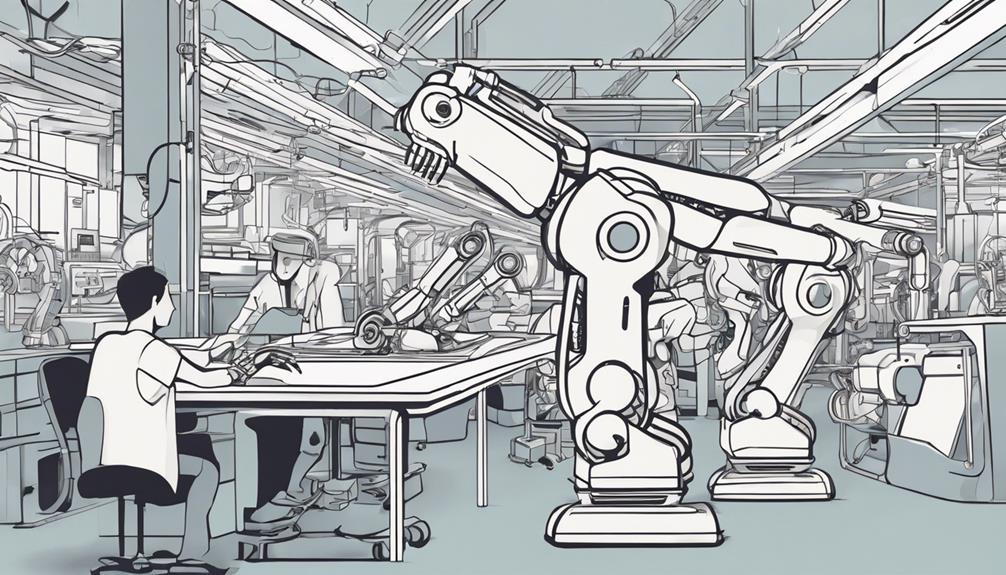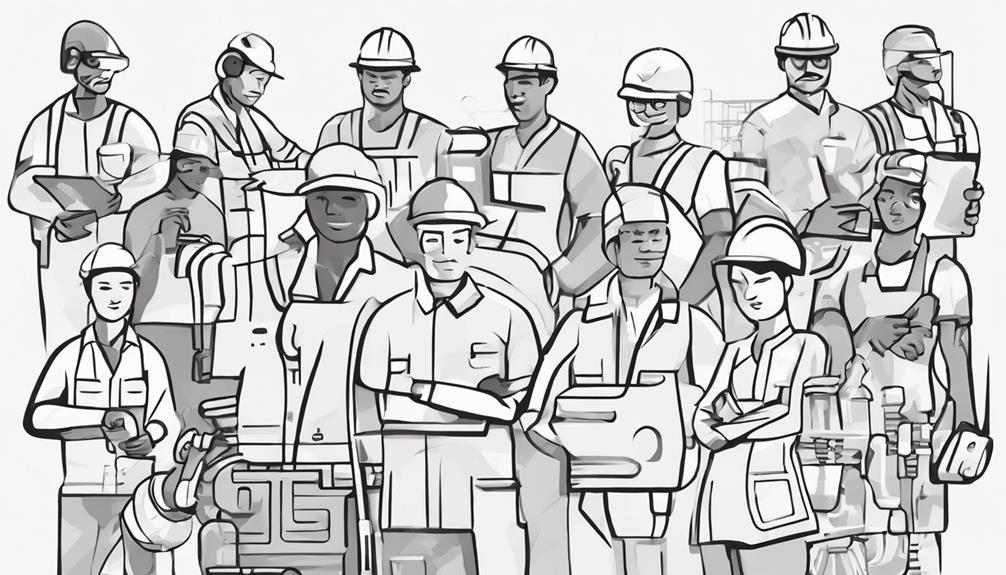The future of work and economy stands at a pivotal juncture, where technological advancements and shifting demographics are reshaping traditional employment structures. As societies grapple with the implications of automation and globalization, questions arise about the sustainability of current economic models and the adaptability of the workforce. Understanding the intricacies of these transformative forces is essential for preparing for the uncertainties that lie ahead, prompting a deeper examination of the strategies needed to navigate this evolving landscape effectively.
Key Takeaways
- Remote and hybrid work models are evolving post-COVID, emphasizing strategic clarity and technology adoption.
- Workforce transitions are essential with over 100 million workers needing to switch occupations by 2030.
- Automation will reshape labor, potentially impacting 30% of global work hours by 2030.
- Gig economy growth offers flexibility but requires support for skill development and job transitions.
Remote and Hybrid Work Trends

The evolution of work paradigms towards remote and hybrid models presents a transformative shift in contemporary workforce dynamics. With 20 to 25% of workforces in advanced economies potentially engaging in remote work for 3 to 5 days a week post-COVID-19, the landscape of work environments is rapidly changing. However, it is crucial to note that over half of the workforce, particularly in low-wage jobs, still lacks remote work opportunities. This discrepancy highlights the need for inclusive policies that cater to all sectors of the workforce.
Moreover, not all tasks are conducive to remote settings, such as negotiations and brainstorming sessions that require face-to-face interaction. Hence, the rise of hybrid work setups, which blend on-site and remote work, is a practical solution that is likely to persist. Organizations aiming for sustainable performance in this evolving work environment must prioritize strategic clarity, outcome-based management, talent velocity, collaboration, and technology adoption to effectively navigate the challenges posed by remote and hybrid work arrangements.
Evolving Workforce Dynamics
Given the profound impact of technological advancements and global trends on labor markets, the landscape of workforce dynamics is experiencing a significant evolution. The evolving workforce dynamics are characterized by shifting patterns in labor demand and the increasing need for technology adoption. By 2030, it is projected that over 100 million workers globally may need to transition to different occupations, with job growth expected in high-skill sectors such as healthcare and STEM fields. Conversely, middle- and low-skill jobs may face a decline, emphasizing the importance of upskilling and reskilling initiatives. Specific roles like warehouse workers, nurses, and teachers are anticipated to see growth, while jobs like grocery store clerks are at risk due to automation. The COVID-19 pandemic has accelerated remote work trends, with estimates suggesting that 20-25% of advanced economy workforces could work remotely on a regular basis. In this context, the adoption of technology and the implementation of hybrid work setups combining on-site and remote work will be crucial for ensuring sustainable performance and organizational success in the evolving landscape of workforce dynamics.
Automation's Impact on Labor

In the evolving landscape of workforce dynamics, the impact of automation on labor presents a critical challenge requiring strategic foresight and proactive measures.
Key Points:
- Automation Potential: Automation has the capacity to automate up to 30% of global work hours by 2030, indicating a significant shift in how work is done.
- Occupational Impact: Currently, less than 5% of occupations can be fully automated with existing technologies. However, the impact of automation varies across sectors and occupations, with more routine and predictable environments facing higher levels of automation.
- Labor Force Transitions: It is estimated that between 75 million to 375 million individuals may need to transition to different occupational categories due to automation. This necessitates strategic planning and policy decisions to manage these workforce transitions effectively.
In navigating the complexities of automation's influence on the labor force, understanding these nuances is crucial for anticipating changes in job growth and ensuring a resilient labor force for the future.
Employment Growth Scenarios
The evolving landscape of employment growth scenarios presents a complex interplay of job automation impacts and trends in the gig economy. As technological advancements continue to reshape industries, the need for reskilling and upskilling becomes imperative to adapt to changing job demands. Understanding these scenarios is crucial in preparing the workforce for the future labor market dynamics.
Job Automation Impact
With the rapid advancement of automation technologies, the potential displacement of 400 million to 800 million individuals by 2030 necessitates a strategic approach to workforce transitions and skill acquisition.
Key Points:
- Occupational Shifts: Automation will lead to significant changes in occupations and necessary skills.
- Skill Development: Individuals may need to transition to new job categories and acquire new skills.
- Policy Importance: Strategic planning and policy decisions are crucial to manage the impact of automation effectively.
The predicted 8 to 9 percent increase in labor demand for new occupations by 2030 underscores the importance of prioritizing skill development and providing support for job transitions in the face of job automation.
Gig Economy Trends
Analyzing the trajectory of gig economy trends reveals varied scenarios for employment growth, influenced by regulatory dynamics and technological advancements. Projections suggest gig economy platforms could potentially add 72 million full-time equivalent positions by 2025, with growth estimates ranging between 24 million to 72 million based on different scenarios. The gig economy, encompassing areas such as ride-sharing, food delivery, and freelance work, offers flexibility to workers but also raises concerns regarding job security and benefits. Factors like regulatory changes and technological advancements play significant roles in shaping the employment growth within the gig economy. As this sector continues to evolve, understanding the nuances of job creation and the dynamics of the gig economy becomes crucial for policymakers and stakeholders alike.
Global Variances in Automation Effects

An analysis of global variances in automation effects reveals significant disparities in the potential impact on work hours across different regions by 2030. This disparity stems from various factors such as the current state of the labor market, digital talent availability, and the level of technological integration within each region.
Key Points:
- Labor Market Conditions: Regions with a higher proportion of routine-based jobs are more susceptible to automation effects, leading to a greater impact on work hours.
- Digital Talent Availability: Areas with a skilled workforce adept at utilizing and adapting to digital technologies are likely to experience a smoother transition in the face of automation, potentially mitigating the negative effects on work hours.
- Technological Integration: Regions that have embraced automation and digitalization in their industries are more prone to witness significant shifts in work hours as automation continues to advance.
Understanding these global variances is crucial for policymakers and businesses to strategize reskilling efforts and workforce planning, ensuring a smoother transition into the automated future.
Reskilling Displaced Workers
In the face of impending automation displacing millions of workers, the urgency of reskilling programs cannot be overstated. Training individuals in new skills, providing job placement support, and offering lifelong learning opportunities are crucial components in preparing displaced workers for the evolving job market. Ensuring that these initiatives are implemented effectively will be essential to mitigate the negative impacts of automation on the workforce and promote sustainable economic growth.
Training for New Skills
Strategically implementing comprehensive reskilling programs is imperative to address the imminent displacement of millions of workers due to automation by 2030.
Key Points:
1) Magnitude of Displacement: Over 400 million to 800 million individuals globally are at risk of being displaced by automation within the next decade.
2) Scope of Reskilling: Countries like the U.S., Germany, and Japan are projected to have a significant portion of their workforce requiring new skills to adapt to changing job landscapes.
3) Necessity of Intervention: Effective strategic planning and policy decisions are essential to facilitate the transition of 75 million to 375 million individuals who may need to switch occupational categories to remain relevant in the evolving job market.
Job Placement Support
To effectively address the displacement of millions of workers due to automation by 2030, a robust system of job placement support must be established to facilitate the reskilling of affected individuals. With between 400 million to 800 million individuals at risk of displacement, job placement support plays a crucial role in guiding these workers towards new opportunities. Strategic planning and policy decisions are paramount to assist the 75 million to 375 million individuals who may need to transition to different occupational categories and acquire new skills. Given that less than 5% of occupations can be fully automated, job placement support tailored to the needs of displaced workers is essential. Addressing the impact of automation on skills and wages is vital for successful workforce transitions and job placement. Support mechanisms including income and transition assistance are fundamental in managing the potential disruptions caused by automation and technological advancements.
Lifelong Learning Opportunities
Efficiently addressing the impending displacement of a significant portion of the workforce due to automation by 2030 necessitates a proactive approach towards providing lifelong learning opportunities for reskilling displaced workers.
Key Points:
- Scale of Displacement: With 400 million to 800 million individuals facing displacement, lifelong learning opportunities are crucial.
- Skill Adaptation: Approximately one-third of the workforce in the U.S. and Germany may require new skill acquisition to adapt to automation.
- Policy and Planning: Effective strategic planning and policy decisions are essential for managing workforce transitions successfully.
Skills and Wages in Automation Era
In the era of automation, the correlation between skills and wages becomes increasingly critical as technological advancements reshape the workforce landscape. As work is changing rapidly, studies suggest that automation could impact a significant portion of global work hours by 2030, ranging from almost zero to 30%. While less than 5% of occupations can be fully automated, the need for skill adaptation through upskilling and reskilling is evident. Nearly 60% of occupations may witness automation affecting at least one-third of their activities, emphasizing the necessity for workforce transitions. Notably, workers in predictable environments are more likely to experience job changes due to automation compared to those in roles requiring social interaction. Therefore, managing these transitions and acquiring new skills are crucial steps as automation continues to reshape the workforce landscape. Adapting to the changing demands of the automation era is essential to ensure that individuals remain competitive in the evolving job market.
Addressing Workforce Transitions

As automation reshapes industries and job requirements, the need for individuals to acquire new skills and transition to different occupational categories is becoming increasingly urgent. Retraining opportunities and proactive policies are crucial in facilitating smooth workforce transitions and addressing the potential displacement of millions of workers. Understanding the evolving job market and equipping individuals with the necessary skills are essential components in navigating the shifts brought about by automation.
Skills for New Jobs
A substantial number of individuals are projected to require transitioning to new occupational categories and acquiring additional skills by 2030 to adapt to the impacts of automation. This shift underscores the critical importance of enhancing workforce skills to match the evolving landscape of job opportunities. To effectively address this challenge, it is imperative to consider:
- Identifying Emerging Job Roles: Recognizing the types of jobs that are likely to experience growth and demand in the future can guide individuals in honing the necessary skills for these positions.
- Skill Development Programs: Implementing targeted training programs and educational initiatives can assist workers in acquiring the competencies needed for new job roles.
- Continuous Learning Culture: Fostering a culture of continuous learning within organizations and society can facilitate smoother transitions for individuals needing to adapt their skill sets.
Retraining Opportunities
Enhancing workforce adaptability in response to automation's impact necessitates a strategic focus on retraining opportunities to equip individuals with the requisite skills for emerging job roles. Given that between 75 million to 375 million individuals may need to switch occupational categories by 2030 due to automation, the importance of retraining opportunities becomes evident. An estimated 400 million to 800 million individuals could potentially be displaced by automation, emphasizing the urgent need for effective retraining programs. Strategic planning and policy decisions are crucial to managing workforce transitions successfully. Additionally, economic growth, innovation, and investment are vital in creating new job opportunities to counter automation-related displacements.
| Retraining Opportunities | Displaced by Automation | Strategic Planning |
|---|---|---|
| Equipping individuals with skills | Highlighting the scale of displacement | Essential for managing transitions |
Job Market Shifts
Addressing the dynamic shifts in the job market landscape requires a strategic and proactive approach to managing workforce transitions in response to automation's impact.
- Understanding the supply and demand dynamics in the labor market is crucial for anticipating skill requirements and facilitating smooth transitions.
- Embracing the evolving nature of work by promoting lifelong learning and upskilling initiatives can help individuals adapt to changing job market demands.
- Implementing policies that support reskilling and retraining programs can mitigate the potential disruptions caused by automation, ensuring a more resilient workforce for the future.
HR's Role in Shaping Future Work

HR's pivotal role in shaping the future of work is underscored by its ability to leverage digitization, talent deployment strategies, and data analytics to drive organizational transformation and strategic decision-making. Digitization presents HR with the opportunity to automate processes and utilize employee data effectively, enabling informed decisions. By strategically deploying talent and advising top management on workforce transformation, HR can assist organizations in becoming more agile and adaptive to changing market demands. Establishing HR practice groups focused on specific priorities can further enhance organizational effectiveness in navigating the future of work. Prioritizing the employee experience will be crucial for HR to drive engagement and retention in evolving work environments. Additionally, HR's utilization of data analytics to comprehend talent trends, enhance performance, and make data-driven decisions will play a significant role in shaping the workforce for the future. Through these means, HR is positioned as a key player in driving organizational success amidst the evolving landscape of work dynamics.
Diversity and Inclusion Imperatives
Promoting diversity and inclusion within organizational frameworks is a fundamental prerequisite for fostering a culture of innovation and sustainable growth. In today's rapidly evolving job market, where artificial intelligence is reshaping industries, embracing diversity and inclusion imperatives is more crucial than ever. Here are three key points to consider:
- Enhanced Performance: Prioritizing diversity, equity, and inclusion has been shown to positively impact company performance. Companies that value diversity tend to outperform their competitors, showcasing the tangible benefits of a diverse workforce in the context of the future job landscape influenced by artificial intelligence.
- Social and Economic Disparities: Understanding and addressing social and economic disparities are essential for sustainable growth and engaging the future workforce effectively. By acknowledging and rectifying these disparities, organizations can create a more inclusive environment that fosters innovation and productivity in the era of AI-driven transformations.
- Intersectionality and Inclusivity: Tailoring diversity efforts to consider intersectionality can lead to the creation of more supportive workplace environments. By recognizing the unique experiences and challenges faced by individuals with diverse backgrounds, companies can cultivate a culture of inclusivity that nurtures talent and creativity in the evolving job market influenced by artificial intelligence.
Frequently Asked Questions
What Will Be the Future of Work?
In considering the future of work, it is evident that remote collaboration and automation impact are pivotal factors shaping the employment landscape. The increasing prevalence of remote work setups and the automation of various tasks are altering traditional work structures. As organizations adapt to these changes, individuals must be prepared to enhance their skills to remain competitive in the evolving job market. Embracing technology and upskilling will be essential to navigate the shifting dynamics of the workforce.
How the Future of Work Is Changing?
The future of work is changing rapidly due to the increasing prevalence of remote collaboration and the impact of automation on job dynamics. Remote collaboration tools have facilitated a shift towards virtual work environments, while automation has altered the nature of tasks performed by machines. These changes are reshaping traditional job structures and skill requirements, necessitating a focus on upskilling to adapt to the evolving landscape of work.
What Will Happen to Jobs in the Future?
In the future, job displacement due to automation impact is expected to vary across industries, with some occupations growing while others decline. The evolving job landscape necessitates upskilling and reskilling to adapt to changing demands. Sectors like healthcare and STEM fields may see growth, while roles susceptible to automation, such as clerks and office workers, could face challenges. Understanding these dynamics is crucial for individuals and policymakers to navigate the shifting job market effectively.
What Is the Future of Work 2023?
In 2023, the future of work is expected to continue evolving towards flexibility in schedules and an increased prevalence of remote work. Organizations are likely to further embrace hybrid work models, enabling employees to work from anywhere. This shift may lead to improved work-life balance, enhanced productivity, and reduced operational costs. As technology continues to advance, the trend towards flexible and remote work arrangements is expected to persist and become more ingrained in the fabric of modern workplaces.
Conclusion
In conclusion, the future of work and the economy is a complex landscape shaped by technological advancements, shifting skill requirements, and evolving workforce dynamics. As automation continues to reshape industries, the need for retraining and upskilling becomes crucial. Collaboration between policy makers, businesses, and individuals is essential to navigate these transitions effectively. Embracing innovation, fostering entrepreneurship, and prioritizing sustainability are key components in building a resilient and inclusive economy for the future. The possibilities for growth and adaptation in this ever-changing environment are limitless.
